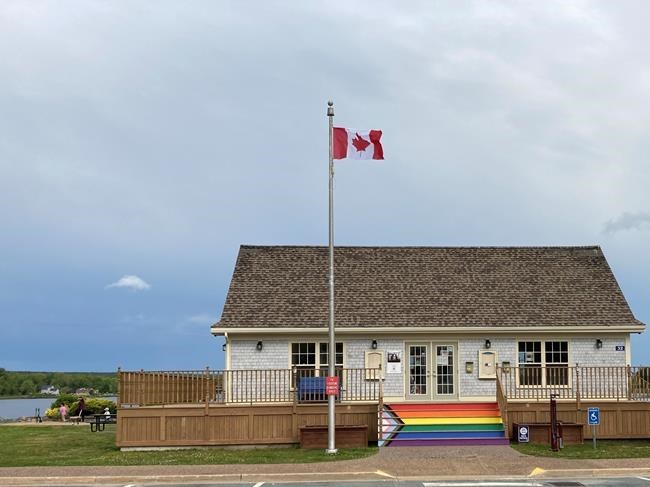HALIFAX ā Pride organizers in rural Nova Scotia say recent acts of homophobic vandalism serve as a reminder that despite progress, for some itās still not safe to be out in rural communities.
The RCMP says the recent vandalism in Liverpool, N.S., and Lawrencetown, N.S., is being investigated as criminal mischief that appears to have been motivated by prejudice or hate against people based on their sexual orientation.
Steve Ellis, chair of the Pride festival in Lunenburg, N.S., about 70 kilometres northeast of Liverpool, said he was disturbed to see a Jan. 9 photo of the Liverpool visitor information centre with homophobic slurs and other hateful terms spray-painted on its rainbow-coloured front steps.
āThe words used on the building are cruel and harmful,ā said Ellis, whose Lunenburg Pride festival is the largest LGBTQ event on the province's South Shore.
āItās something weāve seen happen in other jurisdictions but not often here. Though, I think it happens more than we realize,ā Ellis said of graffiti and vandalism that contain hate speech against LGBTQ people.
Ellis said that the hate-motivated vandalism shows that while progress has been made in the South Shore region -- including the success of the first Lunenburg Pride Week last summer -- more work needs to be done to tackle homophobia.
āOut this way and in other rural areas, there's definitely at times homophobic or transphobic undercurrents,ā Ellis said. āIt might feel settled sometimes, but it's still there.ā
In December, a Pride flag hanging on a new general store in the Annapolis Valley village of Lawrencetown was torn down four times and each time replaced by the married queer couple that own the store.
The last time, on Christmas Eve, the newest flag was ripped down and defecated on.
Sue Littleton, who co-owns the Lawrencetown Beeās Knees General Store and Bakery with her spouse, said they āwonāt tolerate that kind of threat,ā adding that security cameras and new Pride flags are in place.Ā
Ellis said the presence of a simple Pride flag is important and can be a sign of safety for people who arenāt comfortable coming out.
āIf they see a flag, or in Liverpool the beautiful rainbow stairs they have, that might make them feel safe,ā he said. āBut this (vandalism) tries to reverse all of that.ā
Ellis said this incident will not deter his organization from continuing to put on Pride events in the South Shore.Ā
Littleton, who grew up in the Annapolis Valley and lived for years in Ontario before returning to her home province in 2022, said that while the vandalism was āaggressive," what sticks out is the overwhelming support she and her spouse received from the community.Ā
āWe had folks coming from all over the valley to show their solidarity and support and people have been sending us Pride flags, which has been so amazing,ā she said.Ā
Littleton said when she was living in the Annapolis Valley about 15 years ago, she āwouldnāt have dreamt of being out.āĀ
āIt just didnāt feel like a safe place at all. But I feel like itās really, really changed so much over the last decade,ā she said.Ā
Since moving to Lawrencetown in 2022, Littleton and her spouse, Candice Zaina, feel they have found āa little pocket of acceptanceā in the province.
Littleton said that among those who came from other parts of Nova Scotia to deliver Pride flags were some young people who had driven up from the Liverpool area. They shared with her that they donāt feel safe to be out in their home communities.
This was a reminder of the importance of representation and safe queer spaces, she said.
āCandice and I are both in our 40s; we've been out for a long time and we're comfortable in who we are," Littleton said. "That allows us to be more fearless; we don't have to worry about the repercussions from family or community.
āBut I don't think that that's true for a lot of young people.ā
This report by The Canadian Press was first published Feb. 7, 2023.
---
This story was produced with the financial assistance of the Meta and Canadian Press ¾¢±¬“ó¹Ļ Fellowship.
Lyndsay Armstrong, The Canadian Press
Note to readers: This is a corrected story. A previous version situated one of the acts of vandalism in the wrong Lawrencetown.



